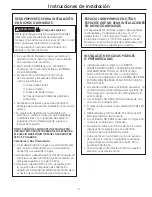
EXHAUSTING THE DRYER (cont.)
Installation Instructions
BEFORE YOU BEGIN
•
Remove and discard existing plastic or metal foil
duct and replace with UL-listed duct.
•
Remove any lint from the wall exhaust opening.
Internal
Duct
Opening
Wall
Check that exhaust
hood damper opens
and closes freely.
STANDARD REAR EXHAUST
We recommend that you install your dryer before
installing your washer. This will permit direct
access for easier exhaust connection.
Slide the end of the exhaust duct on the back of the
dryer and secure with duct tape or a hose clamp.
NOTE:
We strongly recommend using rigid metal
exhaust duct.
•
For straight-line installation, connect the dryer
exhaust to the wall, using duct tape.
RECOMMENDED CONFIGURATION TO
MINIMIZE EXHAUST BLOCKAGE
Using duct elbows will prevent duct kinking and
collapsing.
Duct
Transition
Ducting
Wall Side
Dryer
Side
14
EXHAUST SYSTEM CHECKLIST
HOOD OR WALL CAP
•
Terminate in a manner to prevent back drafts or entry
of birds or other wildlife.
•
Termination should present minimal resistance to
the exhaust airflow and should require little or no
maintenance to prevent clogging.
•
Wall caps must be installed at least 12” above ground
level or any other obstruction with the opening
pointed down.
•
Never vent the dryer out of the roof.
SEPARATION OF TURNS
•
For best performance, separate all turns by at least
4 ft. of straight duct, including distance between last
turn and dampened wall cap.
SEALING OF JOINTS
•
All joints should be tight to avoid leaks. The male end
of each section of duct must point away from the
dryer.
•
Duct joints should be made air- and moisture-tight
by wrapping the overlapped joints with duct tape or
aluminum tape.
•
Do not assemble ductwork with any fasteners
that extend into the duct. These fasteners can
accumulate lint, creating a potential fire hazard.
•
Horizontal runs should slope down towards the
outdoors 1/4” per foot.
•
Provide an access for inspection and cleaning of
the exhaust system, especially at turns and joints.
Exhaust system shall be inspected and cleaned at
least once a year.
INSULATION
•
Ductwork that runs through an unheated area or is
near air conditioning should be insulated to reduce
condensation and lint buildup.















































